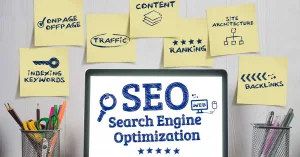Website traffic is vital to your business’s success. Without visitors to your site, you’ll struggle to generate leads, engender brand loyalty, and sell your products or services. If you’ve spent a great deal of time and money building the best site possible, it can be even more frustrating to watch your site traffic plateau or never get off the ground at all.
However, there are a few simple techniques you can employ to make sure your site traffic grows with every new post. In this post, we’ll detail 6 tried and true methods for building traffic to your website, and exactly how you can put them into practice today.
Set Your Site Growth Goals
First things first, it can be helpful to create a growth plan for your site. This plan should detail how much growth you’re aiming for in a certain amount of time, and how you want to get there.
At this stage, some helpful questions to ask are:
- How much traffic to my site do I want to generate?
- How much time can I dedicate to building website traffic?
- What resources can I dedicate to building website traffic?
Set Realistic Goals
Remember to be realistic with your goals. They’ll be much easier to achieve, spurring further growth, and you can make changes where necessary without rocking the boat. If your business has a marketing team or marketing strategy already in place, it can be helpful to get employees involved with your site growth strategy. You should synthesize any existing marketing strategies with your site growth plan to make sure your site content and brand are cohesive.
Set Realistic Deadlines
Shorter time spans for growth plans (around 3-6 months) are best, as you can accurately measure which traffic-driving techniques are working well, and which ones you’ll need to dedicate some more time to. In the early stages of building site traffic, regularly reworking your plan is beneficial to tailor those techniques that aren’t working. However, many traffic-building techniques, especially in the earliest stages of site growth, will take a while to show results, so be sure not to completely throw out a method before it’s had a chance to take hold.
6 Ways to Build Site Traffic
Once you know exactly what you’re working with and working towards, you can decide what techniques you’re going to apply. Here are 6 tried and true methods that can help generate site traffic no matter how old your site is.
- Employ a People-First Approach to Content
It’s estimated that between 75-95% of web traffic goes to sites on the first page of search results. If you’ve got your site up and running and are looking to build traffic, you’ve likely come across this statistic before. However, it’s stats like these that lead many business owners to prioritize SEO above everything else, dedicating all their time and resources to appearing on that coveted first page.
Once upon a time, it was easy to cheat the search engines’ algorithms by packing keywords into your content and elsewhere on your site. However, while this may get your site in front of more people, those visitors will easily be able to tell that your site isn’t people-focused. The content will likely be vague, catching as many keywords as possible, and sometimes illegible due to overuse of these keywords.
But, since SEO is what gets these visitors onto your site in the first place, you might find yourself caught between these two aims. The key to generating traffic is in finding the balance between peppering relevant keywords through your site and producing high-quality content that genuinely helps, educates, or entertains site visitors. In general, making sure content is readable and enjoyable should be your priority, swiftly followed by subtle and organic SEO.
- Keep Your Content Fresh
If you have one or two pages on your site or a few blog posts that tend to generate more traffic than others, focus on keeping this content fresh. Again, this applies to both SEO and the quality of content on these pages. Refreshing your content not only ups the chances of it appearing in search engine results but also keeps your site active, current, and reliable.
If one of your blog posts or helpful pages has become outdated or inaccurate, updating this information is vital. For example, if you’re creating content on how to capitalize on market trends, this post needs to keep up with those trends as they evolve. If you’ve created further content that relates to an older post, linking internally to these posts can increase time spent on your site, generate traffic to underperforming pages, and improve your rankings.
This method can also work well for content that isn’t performing as well as it should be. For example, you could try a new click-worthy headline on some of your less popular content, or re-publish an updated blog post as an entirely new page. Finally, using keywords that are specific, but will continue to be searched for by potential visitors is a great way to keep content evergreen.
- Optimize User Experience
In 2023, users aren’t just visiting your site on desktop devices. Many site hosts such as Squarespace and WordPress will have mobile and tablet optimization built in, meaning traffic to your site can come from a variety of devices. Making sure all visitors, no matter what device they’re using, receive the same, high-quality experience on your site is a great way to drive traffic and reduce your bounce rate.
Digital marketing agency Portent found that conversion rates for e-commerce sites that load in 1 second were 3 times higher than those sites that took 5 seconds to load. To add to this, for every additional second your site takes to load, it’s estimated that 4.42% of visitors will exit your site. So, how do you improve your site loading times? If your site is image heavy, compressing any images and video using host plug-ins or free sites such as Squoosh can greatly improve site speed. Or, if there are some particularly important pages on your site, you can cache these pages also by using a dedicated plug-in. Caching a page means the server requires fewer resources to load the page, improving site speed.
However, improving load speed isn’t the only way to optimize the user experience on your site. Site navigation should be as simple as possible. For example, if you’re creating content that explains how to use your products, a link to the product page at the start and end of the post is a given. As well as a contact page with all your relevant information, it may also be worth installing a live chat function to assist visitors as and when they need it.
- Build a Network
If you’re in the early stages of building traffic to your site, it can be tempting to see those that are more established as your competition. However, your site will benefit far more from partnerships with other established sites than it will be working against them. Building partnerships with these sites can be mutually beneficial, and get your site the traffic it deserves.
A great way to start building partnerships is by reaching out to other sites to pen guest posts. While writing for another site may seem counter-productive, by including helpful links back to your site and writing a killer ‘author biography’ you can drive traffic and legitimize your business and personal branding. Be sure to welcome guest posts on your site, too.
Once you’ve established these partnerships through guest posts, you can reach out to other site owners when you’re releasing new content in your shared niche. By making them aware ahead of time, these site owners will be more likely to share your work on their site when it’s published.
- Don’t Underestimate Social Media
Setting up social media for your business is almost considered vital to creating a trustworthy brand. However, if you’re already trying to build traffic to your site, focusing on growing your social media too can be a big commitment. But social media is a cost-effective, often completely free, way to drive site traffic.
If you’re just starting out, select a few social media sites that align with your business and site niche. For example, if you market B2B services, LinkedIn is a must-have to generate leads, foster industry connections, and drive site traffic. Or, if your brand focuses on being informative and helpful, a regular podcast or active YouTube channel is a great way of utilizing social media. By maintaining a cohesive brand across multiple social media platforms and your site, you can create a symbiotic relationship wherein traffic to your social media automatically translates into site traffic.
However, if you don’t want to commit to social media just yet, it can still assist you as you build traffic to your site. Creating shareable content that appeals to social media users and influencers alike can see traffic to your site coming from unlikely places. By adding a ‘click to share’ button on your site, you can make it far easier for people to share content on the most widely used social media, such as Facebook and Twitter. Adding eye-catching info-graphics and video content to your posts is another easy way to make your site shareable.
- Reward Visitors
Finally, an easy way to drive traffic to your site is to reward site visitors. You can do this by pushing a mailing list sign-up. Once you have these leads, you can send them newsletters, early access to new products, and discount codes. Or, you can advertise giveaways and competitions on your site which will drive traffic organically.
These methods can be beneficial to your business as a whole, by advertising rewards in return for participating in polls or filling out surveys. This can help you drive traffic to your site, as well as glean valuable feedback for what your site visitors are looking for. By implementing changes that are frequently requested, you can improve your site and drive traffic in the long run.
In Conclusion…
Driving traffic to your site is no mean feat, no matter how long your site has been up and running. It involves a lot of hands-on work to improve user experience, reduce load times, reward visitors, and pay close attention to your content to make sure it’s evergreen and sharable. Setting clear goals for your site will help you understand how much time you have to drive traffic, and what the best methods are to do just that.
Applying a host of techniques at once may help you achieve your goals faster, but will take a lot of time and dedication to make sure they’re working long-term. Instead, be patient. Try one technique at a time to improve your site, and record the results. Over time, you can build up your methods until your site employs all traffic-building techniques simultaneously.
Good luck!
Sources
- https://databox.com/website-traffic-goals
- https://www.geckoboard.com/best-practice/kpi-examples/website-traffic-growth/
- https://www.brafton.com/news/95-percent-of-web-traffic-goes-to-sites-on-page-1-of-google-serps-study/
- https://www.portent.com/blog/analytics/research-site-speed-hurting-everyones-revenue.htm
- https://backlinko.com/increase-website-traffic
- https://www.shopify.com/uk/blog/how-to-increase-website-traffic
- https://mailchimp.com/en-gb/resources/5-ways-to-increase-website-traffic/
- https://www.spoonity.com/website-visitors-loyalty-members/





















Add comment